
Beech Bark Disease
INSECT & FUNGUS Cryptococcus fagisuga & Neonectria spp. Description Disfigured Beech trees are the result of a combination of the exotic Beech Scale insect and two fungus species, one of
Invasive species are plants, animals and micro-organisms that have been introduced into areas beyond their native range and negatively impact the environment, the economy, or society.
It is widely accepted that invasive species are an immense threat to biodiversity worldwide. In Canada alone, more than 20% of our species at risk are threatened with extinction by invasive species. Invasive species cause harm in several ways. For example, they may eat native species, take their food and space, contribute to soil degradation and erosion, introduce new diseases, and degrade water quality and habitat. The destruction caused by invasive species also has adverse effects on human life. Invasive species can damage buildings and roads. From an economic viewpoint, invasive species greatly impact productivity and profit in forestry, agricultural, and fishing industries – as well as reducing recreational opportunities.
Humans are largely responsible for the movement of invasive species from one area to another. Many human-assisted pathways have permitted the introduction of invasive species in Nova Scotia. Examples of these pathways include – but are certainly not limited to – horticultural trade, aquarium trade, the movement of shipping containers, ballast water tanks in cargo ships, recreational boating, and the release of species for hunting or angling purposes. Once established, invasive species can spread naturally, or be moved further by human activities such as outdoor recreation, release of pets into the environment, or movement of firewood.
Everyday activities often contribute to the spread of invasive species. For example, buying products from overseas requires transportation via container ships; those ships may inadvertently transport invasive species to Nova Scotia. Buying local products and reducing your overall ecological footprint not only helps to reduce habitat destruction, climate change, pollution, and overexploitation of natural resources – it is also fundamental for the prevention of invasive species introductions across the globe.
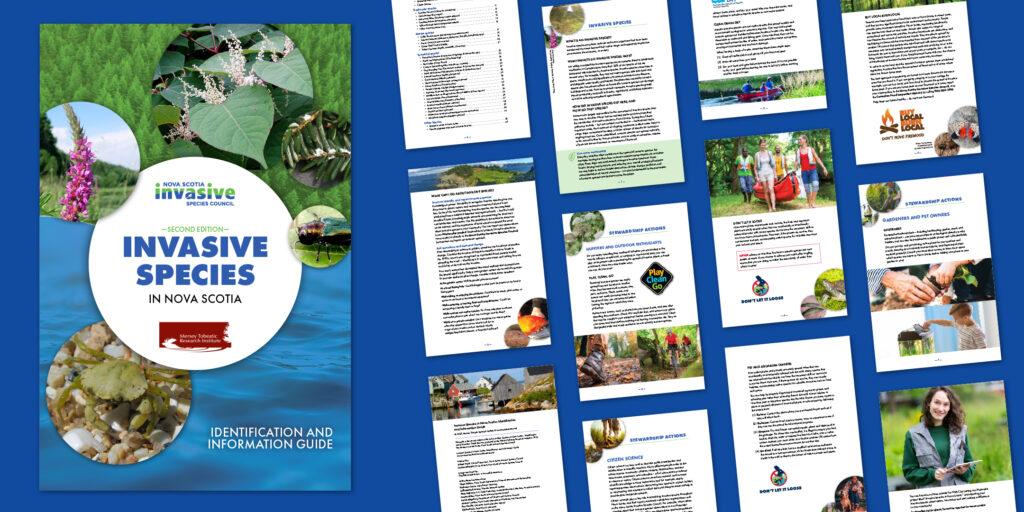

INSECT & FUNGUS Cryptococcus fagisuga & Neonectria spp. Description Disfigured Beech trees are the result of a combination of the exotic Beech Scale insect and two fungus species, one of

INSECT Orchestes fagi Description The Beech Leaf-Mining Weevil is an insect pest of Beech (Fagus spp.) trees. Adult weevils are 2–3 mm long, with short golden hair, and long back
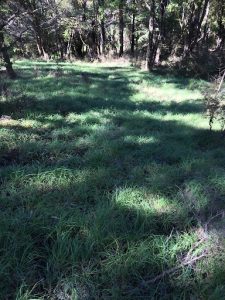
VASCULAR PLANT Carex flacca Description Cool-season sedge grow to a height of 30-45 cm and a width of 30-45 cm, forming a dense clump that slowly creeps and spreads. It
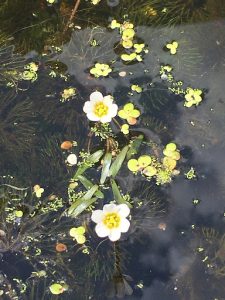
VASCULAR PLANT Cabomba caroliniana Description Bottom-rooted, submersed aquatic plant. Stems usually 1-2 m but up to 10 m long. Underwater leaves opposite, fan-like and finely divided; floating leaves small, oblong,
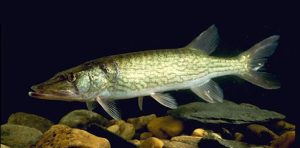
FRESHWATER FISH Esox niger | Other Names: Pickerel, Water Wolf, Pike Description Long, narrow, torpedo-shaped, green body with a darker back and white belly. Adults have chain-like pattern on sides;

FRESHWATER SNAIL Cipangopaludina chinensis Description The size of Chinese Mystery Snails varies, but when fully developed, they can grow up to 6.5 to 7 cm long, with a thick and

MARINE ANIMAL Membranipora membranacea | Other Names: Lacy Crust Bryozoan, Kelp Lace Bryozoan Description The Coffin Box Bryozoan is a marine organism that consists of tiny (< 1 mm in
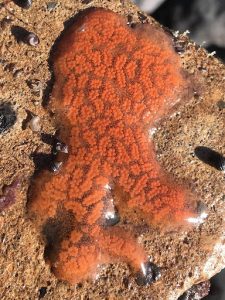
MARINE ANIMAL Didemnum, Diplosoma, Botryllus, Botrylloides spp. | Other Name: Sea Squirt Description Colonial Tunicates are small marine filter-feeding animals, sometimes referred to as sea squirts. They live attached to

VASCULAR PLANT Phragmites australis ssp. australis | Elephant Grass, Giant Reedgrass Description Very tall, stout grass, often reaching heights of 3 m or more (exceptionally to 4 m). Stem hollow,
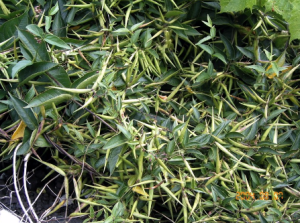
VASCULAR PLANT Vincetoxicum rossicum & V. nigrum | Pale Swallowwort, Black Swallowwort Description Herbaceous vine growing 1-2 metres high and twining onto plants or trees. Leaves are opposite, oval with
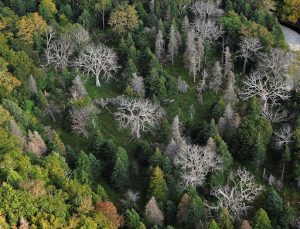
INSECT & FUNGUS Hylurgopinus, Scotylus, & Ophiostoma spp Description Dead and dying White Elm trees. Results from several different microscopic sac fungi (all of which are probably exotic) that infect
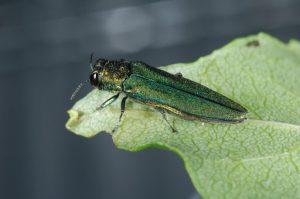
INSECT Agrilus planipennis Description The Emerald Ash Borer is a narrow, elongated beetle that is 8.5–14 mm long, and 3.1 –3.5 mm wide. Adults have a metallic-green back and bright-emerald
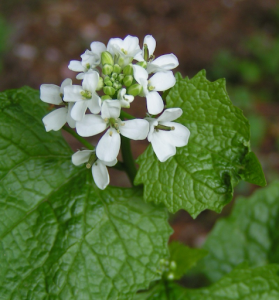
VASCULAR PLANT Alliaria petiolata Description Herbaceous biennial, with vegetative rosette in the first year. Leaves 2-12 cm wide, dark green, kidney shaped, smelling of garlic when crushed, margins scalloped. Taproot

VASCULAR PLANT Heracleum mantegazzianum Description A perennial member of the carrot family which can grow to exceed 5m in height. Basal leaves lobed, coarsely toothed, reaching 3m in length, glabrous

VASCULAR PLANT Frangula alnus | European Alder Buckthorn Description Single or many stemmed shrub or small tree, reaching heights of 6 m. Leaves alternate along the stem, oval-shaped, 3 to
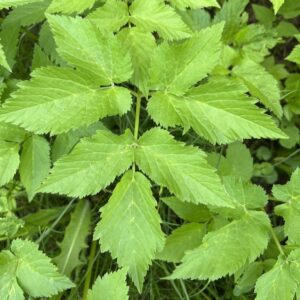
VASCULAR PLANT Aegopodium podagraria | Other Names: Bishop’s Goutweed, Ground Elder Description Goutweed is a fast-spreading perennial in the carrot/parsley family (Apiaceae) that forms dense patches through aggressive underground rhizomes. Most
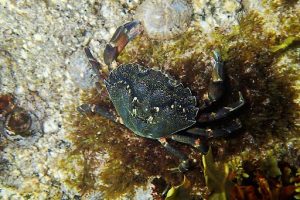
CRUSTACEAN Carcinus maenas | Other Name: European Green Crab Habitat & Impact Green Crabs are common in shallow water of salt marshes, beaches and rocky coasts, or in vegetation. They
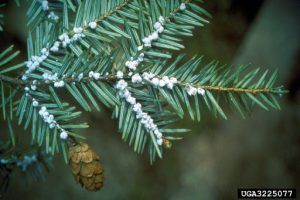
INSECT, TREE PEST Adelges tsugae Description Hemlock Woolly Adelgid is an aphid-like insect that parasitizes Eastern Hemlock (Tsuga canadensis) trees. The first generation of the bug are 1.4 mm long,
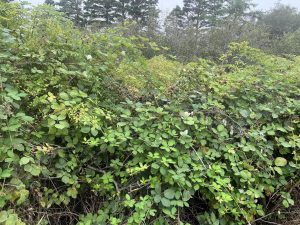
VASCULAR PLANT Rubus bifrons Description Himalayan Blackberry is a very large blackberry that produces robust arching 5-angled canes that reach up to 3 m in height and 12 m in

VASCULAR PLANT Berberis thunbergii | Red Barberry, Thunberg’s Barberry Description Japanese Barberry is a deciduous, woody shrub in the barberry family (Berberidaceae). It has small, oval, spoon-shaped leaves with smooth

VASCULAR PLANT Reynoutria japonica | Other Names: Mexican Bamboo, Fleeceflower Description Japanese Knotweed is a woody-stemmed herbaceous perennial 1-3 m tall, with annual stems extending from the perennial root system.
INSECT & FUNGUS Cryptococcus fagisuga & Neonectria spp. Description Disfigured Beech trees are the result of a combination of the exotic Beech Scale insect and two fungus species, one of […]
INSECT Orchestes fagi Description The Beech Leaf-Mining Weevil is an insect pest of Beech (Fagus spp.) trees. Adult weevils are 2–3 mm long, with short golden hair, and long back […]
VASCULAR PLANT Carex flacca Description Cool-season sedge grow to a height of 30-45 cm and a width of 30-45 cm, forming a dense clump that slowly creeps and spreads. It […]
VASCULAR PLANT Cabomba caroliniana Description Bottom-rooted, submersed aquatic plant. Stems usually 1-2 m but up to 10 m long. Underwater leaves opposite, fan-like and finely divided; floating leaves small, oblong, […]
FRESHWATER FISH Esox niger | Other Names: Pickerel, Water Wolf, Pike Description Long, narrow, torpedo-shaped, green body with a darker back and white belly. Adults have chain-like pattern on sides; […]
FRESHWATER SNAIL Cipangopaludina chinensis Description The size of Chinese Mystery Snails varies, but when fully developed, they can grow up to 6.5 to 7 cm long, with a thick and […]
MARINE ANIMAL Membranipora membranacea | Other Names: Lacy Crust Bryozoan, Kelp Lace Bryozoan Description The Coffin Box Bryozoan is a marine organism that consists of tiny (< 1 mm in […]
MARINE ANIMAL Didemnum, Diplosoma, Botryllus, Botrylloides spp. | Other Name: Sea Squirt Description Colonial Tunicates are small marine filter-feeding animals, sometimes referred to as sea squirts. They live attached to […]
VASCULAR PLANT Phragmites australis ssp. australis | Elephant Grass, Giant Reedgrass Description Very tall, stout grass, often reaching heights of 3 m or more (exceptionally to 4 m). Stem hollow, […]